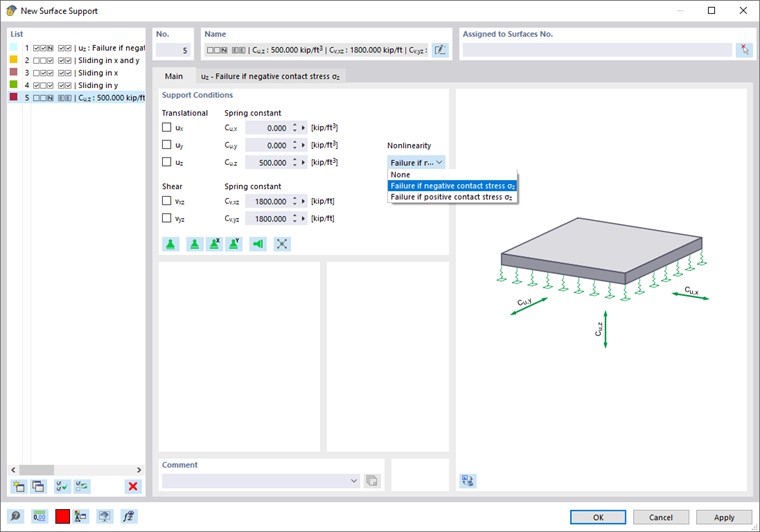A surface support is used to support surfaces in RFEM. The support conditions ux, uy, and uz, as well as the shear springs vxz and vyz, can be defined here. It is also possible to consider a nonlinear effect for the uz direction. In combination with the Geotechnical Analysis add-on, it is possible to transfer the spring constants from the soil massif.
A surface support can be assigned to any surface entered in RFEM graphically or using tables. Support conditions can be set either to completely "rigid" or "elastic" by defining a spring stiffness.
Support or Springs in Cu,x, Cu,y, Cu,z
The direction of the supports or springs refers to the local coordinate system of the relevant surface which is assigned to the surface support. The local coordinate system of the surfaces can be displayed using the Display navigator or the shortcut menu.
The support perpendicular to the surface is controlled by entering Cu,z. The entries for Cu,x and Cu,y describe the resistance against the displacement of the plate in the x- and y-directions.
Shear Springs Cv,xz, Cv,yz
By entering values in these boxes, the shear resistance of the soil is considered in the direction of the surface axes x or y. In most cases, the Pasternak constant Cv is between 0.1 ⋅ Cu,z (low shear resistance) and 0.5 ⋅ Cu,z (average shear resistance). Cv,xz = Cv,yz can usually be applied. If the support in uz has been set to "rigid" (see Image 01), no entry is possible for the shear springs Cv,xz and Cv,yz.
Theoretical Background
The theoretical background of the "Effective Soil Model" implemented in RFEM is documented in Chapter 4.9 Surface Supports of the RFEM 5 manual.
Results for Surface Supports
Once surface supports have been used in a model, the contact stresses σz, τyz, and τxz are available as a result after the calculation. The table "Surfaces | Contact Stresses" shows the resulting sum of support forces for the entire surface.
